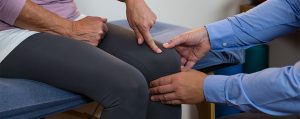Returning to Exercise Postpartum
After giving birth, a lot of questions arise on how to return to a workout program safely once cleared by your doctor. Every birth is different (vaginal delivery vs caesarian section), so it’s important to discuss with your doctor before returning to exercise. Typically, walking and gentle exercises are permitted immediately after birth, but most doctors do not clear women for impact activities until at least 6 weeks postpartum. Certain women’s recoveries will be longer, and it is important to ease into abdominal strengthening. Starting a vigorous workout too early can cause problems such as incontinence or prolapse of the pelvic floor (when organs in the pelvis slip down from their normal position).
Move Your Workouts Indoors with Resistance Bands
In this current environment of the pandemic, some of us are still wary of going to a gym to continue with our fitness routine. Home workouts can grow stale fairly quickly, and we can be unsure of how to proceed. After all, there are only so many ways we can use our bodyweight and products at home to come up with exercises. Several blog posts have been created to get you started with at-home fitness, and this blog will look to expand upon those entries.
How Does Blood Flow Restriction Work?
The Benefits of Blood Flow Restriction
Many patients in our physical therapy clinic are unable to lift heavy weights – sometimes because of pain, immobilization, or because of surgery. Blood Flow Restriction (BFR) Training can be a great rehabilitation tool because it allows patients to reap the benefits of an intense heavy weight-lifting session while only requiring the patient to perform low-to moderate-intensity training. This reduces stress to tissues that may be healing from a recent injury or surgery. During BFR training, a patient or athlete performs high repetitions of a particular exercise while wearing a band or cuff around their upper arm or upper leg with use of light resistance. The following are physical changes that can occur secondary to Blood Flow Restriction Training:
What to Expect From Your First Physical Therapy Appointment
As Physical Therapists, we are musculoskeletal experts treating the muscles, tendons, bones, joints, ligaments and nerves of the body. We diagnose and treat people of all ages, from newborns to weekend warriors to elderly individuals. Many patients have injuries, disabilities, or other health conditions that require physical therapy intervention. But physical therapists also care for individuals who simply want to lead healthier lives to decrease their risk for future injury.
What Is Upper Cross Syndrome/Lower Cross Syndrome?
Upper cross syndrome and lower cross syndrome are terms heard within the world of medicine that, on the surface, sound a little intimidating. However, each term simply refers to muscle weakness and tightness in certain areas of the body that may be contributing to pain and/or reduced functional level. Each “syndrome” entails two predominant areas of muscle tightness and two predominant areas of muscle weakness. Often times, these limitations occur as a result of impaired posture and can lead to pain. Once identified, both upper cross and lower cross syndromes can be effectively treated and managed with physical therapy care.
PT for Pain: Make the Most of Your Deductible
The end of the year often means the resetting of health insurance deductibles (the amount you pay for health care costs before your insurance plan starts to pay). If you’re like me and have met your deductible for the year, now might be the time to address issues that have been plaguing you over the past year and beyond.
The Faces of National Physical Therapy Month
During National Physical Therapy Month, we recognize our hard-working therapists and the positive impact they have on our patients’ lives. Throughout the month of October, we’ve highlighted 30+ members of our team across our social media channels to showcase their expertise. Read below to learn more about our clinicians, their specialties, some of their favorite patient stories and the impact they’re making in providing quality care to our patients.
Say No to Pain Killers, Say Yes to Physical Therapy
We are all too familiar with pain; it is truly one of the unfavorable guarantees that we have in life. Whether it be emotional or physical pain, we learn at a young age that pain is a reality that we all must face. In fact, there is a direct link between our physical pain and emotional wellness. Often times, emotional stressors are manifested in our physical ailments. Just as often, we find ourselves with physical impairments that can trigger certain emotional responses affecting our moods and perspectives.
